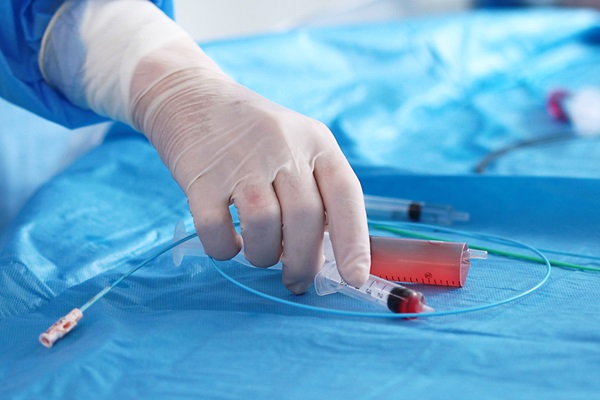Common Blood Clot Disorders and Possible Treatments

Blood clots are something anyone can experience often without realizing it. However, they become dangerous when it becomes a disorder. blood clot disorders, sometimes called coagulation disorders or thrombophilia, pose significant risks to your health if not properly managed or treated.
Understanding blood clot disorders and how an oncologist can help
Blood clot disorders encompass a wide range of conditions that negatively affect the body's coagulation process, leading to clotting. Those with cancer are at an increased risk of developing one of these conditions due to factors such as immobility, surgeries, chemotherapy, radiation therapy, or large or multiple tumors. However, they can also be inherited. The following are the most common types of blood clot disorders we see:
Antiphospholipid syndrome (APS)
APS can also be characterized as an autoimmune disorder due to the abnormal presence of antiphospholipid antibodies in the bloodstream. These antibodies attack certain proteins that bind to the phospholipids, leading to recurring blood clots in the veins or arteries.
Factor V Leiden mutation
Factor V Leiden mutation results from a genetic mutation in the factor V gene involved in normal blood clotting. The factor V gene normally helps regulate blood clotting by interacting with other proteins. However, when this gene is altered, it leads to an increased risk of abnormal blood clot formation.
Prothrombin G20210A mutation
Also known as factor II mutation, prothrombin G20210A mutation is an inherited blood clot disorder. It is a result of excessive prothrombin, a protein that is involved in blood clotting.
Venous thromboembolism (VTE)
VTE results from the obstruction of blood flow due to the formation of blood clots. This obstruction typically occurs in the deep vein of the legs (DVT) or the lungs (a pulmonary embolism). This blood clot disorder is critical as both locations are home to major arteries.
The diagnostic process
The diagnostic process will involve the oncologist ordering imaging and blood tests. The imaging tests may include a computed technology scan (CT), magnetic resonance imaging (MRI), duplex ultrasonography, ventilation-perfusion (V/Q) scan, pulmonary angiography, and contrast venography. The blood test will include checking D-dimer levels. All of these tests will either measure the blood flow in the veins or identify blockages, the presence of clots, or the health of the veins or arteries. While some of these tests are more invasive than others, this process will set the foundation for treatment and identify the severity of the blood clot disorder. However, some results take longer to return than others.
Moreover, the oncologist will perform a physical examination. They will check for leg swelling, breathing capabilities, chest pain, excessive sweating, limb strength, and vision. They will also take the time to see if the patient has been experiencing onset nausea, dizziness, or severe headaches with seemingly no cause.
Potential treatment options
Treatment varies, depending on the type of blood clotting disorder one is experiencing and its severity. Most times, if there are one or two non-critical blood clots or the patient is susceptible to them, but none are immediately present, the oncologist may suggest aspirin for some time. However, for those with recurring blood clots, the oncologist may start with a stronger oral blood thinning medication, such as warfarin, heparin, or others. However, these medications can interfere with other over-the-counter medications, so the oncologist may also recommend an injectable format, such as low molecular weight heparin injectable anticoagulant blood thinners.
These medications aid in the treatment and prevention of blood clots. Furthermore, there are a few procedures the oncologist can perform, namely inferior vena cava, catheter-directed treatments, or surgical thrombectomy:
Inferior vena cava (IVC)
The will oncologist will insert the IVC filter through a small incision in the groin or neck. Their purpose is to prevent blood clots from reaching vital organs. The filter will trap the blood clots within its system. The will oncologist will insert the filter through a small incision in the groin or neck.
Catheter-directed treatments
Also known as endovascular procedures, these minimally invasive procedures involve inserting a catheter into a blood vessel, allowing direct access to the clot site. Using special tools, the oncologist will dissolve or remove the clot (depending on the location), which will restore blood flow.
Surgical thrombectomy
This procedure is more invasive and involves the oncologist making an incision and directly accessing the affected blood vessels or organ(s) where the clot is located. Like the catheter-directed treatment, the aim is to reignite the blood flow. However, the surgery will be introduced when the former fails to yield adequate results.
Schedule an appointment
Blood clot disorders pose more significant health risks than many realize. If you have been recently diagnosed with a blood disorder or are exhibiting any of the mentioned physical symptoms, do not wait to seek treatment. Contact our office and schedule an appointment today.
Request an appointment here: https://lindenbergcancer.com or call Lindenberg Cancer & Hematology Center at (856) 475-0876 for an appointment in our Marlton office.
Check out what others are saying about our services on Yelp: Blood Clot Disorders in Marlton, NJ.
Recent Posts
Blood clot disorders include a spectrum of inherited or acquired conditions that disrupt healthy circulation, elevate the risk of blockage, and threaten vital organs. An oncologist frequently monitors patients for clotting complications because cancer, certain chemotherapies, and reduced mobility intensify thrombotic tendencies. Early recognition of warning signs, together with prompt intervention, significantly lowers the possibility…
Lung cancer treatment has advanced significantly in recent years, allowing for more personalized approaches that improve outcomes and reduce unnecessary side effects. Personalized lung cancer treatment plans are developed based on several factors, including the type and stage of cancer, genetic markers, overall health, and the patient's unique response to specific therapies. These tailored strategies…
An ovarian cancer diagnosis can be scary, as this form of cancer often develops without noticeable symptoms in the early stages. As the disease progresses, it can become more difficult to treat, making early awareness important. Knowing the signs, understanding the diagnostic process, and learning about treatment options from an oncologist can offer patients hope…
Gynecological cancer treatments target cancers that affect the female reproductive organs, such as ovarian, uterine, cervical, vaginal, and vulvar cancers. Fortunately, there have been significant medical advances in cancer treatment that have greatly improved patient outcomes, allowing oncologists to adjust therapies to fit each patient's needs and overall health. These targeted treatments work better than…


